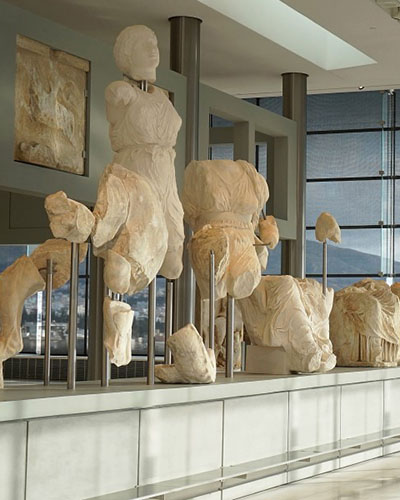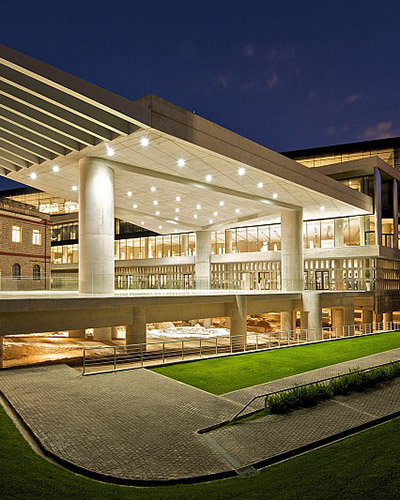National Museum of Natural History
The National Museum of Natural History is a natural history museum administered by the Smithsonian
Institution, located on the National Mall in Washington, D.C., United States. It has free admission
and is open 364 days a year. In 2016, with 7.1 million visitors, it was the eleventh most visited
museum in the world and the most visited natural history museum in the world.[2] Opened in 1910, the
museum on the National Mall was one of the first Smithsonian buildings constructed exclusively to
hold the national collections and research facilities.[3] The main building has an overall area of
1.5 million square feet (140,000 m2) with 325,000 square feet (30,200 m2) of exhibition and public
space and houses over 1,000 employees.
.jpg)
The museum's collections contain over 145 million specimens[4] of plants, animals, fossils,
minerals, rocks, meteorites, human remains, and human cultural artifacts, the largest natural
history collection in the world.[5] It is also home to about 185 professional natural history
scientists—the largest group of scientists dedicated to the study of natural and cultural history in
the world.
.jpg)
Research and collections
.jpg)
The Smithsonian gives an approximate number for artifacts and specimens of 146 million.[42] More
specifically, the collections include 30 million insects, 4.5 million plants preserved in the
Museum's herbarium, and 7 million fish stored in liquid-filled jars.[43] The National Collection of
Amphibians and Reptiles has more than tripled from 190,000 specimen records 1970 to over 580,000
specimen records in 2020.[44][45] Of the 2 million cultural artifacts, 400,000 are photographs
housed in the National Anthropological Archives.[43] Through off-site active loan and exchange
programs, the museum's collections can be accessed.[46] As a result, 3.5 million specimens are out
on loan every year.[43] The rest of the collections not on display are stored in the non-public
research areas of the museum and at the Museum Support Center, located in Suitland, MD.[47] Other
facilities include a marine science center in Ft. Pierce, Florida and field stations in Belize,
Alaska, and Kenya.
.jpg)
Research in the museum is divided into seven departments: anthropology, botany, entomology,
invertebrate zoology, mineral sciences, paleobiology, vertebrate zoology.
One collection of nearly a million specimens of birds, reptiles, and mammals kept at the museum has
been maintained by the Biological Survey unit of the U.S. Geological Survey. This division had
started in 1885 as an economic ornithology unit of the Agriculture Department. Clarence Birdseye and
Clinton Hart Merriam had worked in this organization. As of February 2018, the unit's funding is
planned to be cut, and it is not clear what would happen to the collection.
.jpg)
Hall of Geology, Gems, and Minerals
The National Gem and Mineral Collection is one of the most significant collections of its kind in
the world. The collection includes some of the most famous pieces of gems and minerals including the
Hope Diamond and the Star of Asia Sapphire, one of the largest sapphires in the world. There are
currently over 15,000 individual gems in the collection, as well as 350,000 minerals and 300,000
samples of rock and ore specimens.[49] Additionally, the Smithsonian's National Gem and Mineral
Collection houses approximately 45,000 meteorite specimens, including examples of every known type
of meteorite,[50] and is considered to be one of the most comprehensive collections of its kind in
the world.
.jpg)
Hall of Human Origins
The David H. Koch Hall of Human Origins opened on March 17, 2010, marking the museum's 100th
anniversary. The hall is named for David H. Koch, who contributed $15 million to the $20.7 million
exhibit.
The Hall is "dedicated to the discovery and understanding of human origins," and occupies 15,000 square
feet (1,400 m2) of exhibit space. This exhibit includes 76 humans skulls, each of a different species,
eons apart. Each of these species is a human, signified by the "homo" prefix. One species that can be
found in this gallery is the Homo heidelbergensis, which lived 200,000-700,000 years ago. In addition,
there is a female skull from Homo floresiensis, a human species that possibly only went extinct just
17,000 years ago.[53] The exhibit includes an interactive human family tree that follows six million
years of evolution,[54] and a Changing the World gallery that focuses on issues surrounding climate
change and humans' impact on the world. The Hall's core concept idea is "What Does It Mean To Be Human",
and focuses on milestones of Human Evolution such as Walking Upright, Bigger Brains, and Creating a
World of Symbols. Also covered is the Smithsonian's significant research on the geological and climate
changes which occurred in East Africa during significant periods of Human Evolution. The exhibit
highlights an actual fossil Neanderthal and replicas created by famed paleoartist, John Gurche.[53] The
exhibit has been criticized for downplaying the significance of human-caused global warming.
.jpg)
The exhibit also provides a complementary web site, which provides diaries and podcasts directly from
related fields of research. The Companion Book, What Does It Mean To Be Human was written by Richard
(Rick) Potts, the Curator, and Christopher Sloan. The exhibit was designed by Reich + Petch.
Dinosaurs/Hall of Paleobiology
The Hall of Dinosaurs has fossilized skeletons and cast models, including Tyrannosaurus rex cast facing
a Triceratops cast. The Triceratops exhibit shows the first accurate dinosaur skeleton in virtual
motion, achieved through the use of scanning and digital technology."[58][59] The collection consists of
46 "complete and important specimens" of dinosaurs.
.jpg)
In May 2012, billionaire David H. Koch donated $35 million toward the cost of a $45 million upgrade to
the 30-year-old, 25,000 square feet (2,300 m2) dinosaur hall. The hall closed in the spring of 2014 and
reopened in 2019.
Dinosaurs/Hall of Paleobiology
The Behring Hall of Mammals was designed by Reich + Petch. The mammal specimens are presented as works
of modern art within minimal environmentals. Visitors discover mammal's evolutionary adaptions to hugely
diverse contexts, and ultimately discover that they too are mammals.[citation needed]
The museum has the largest collection of vertebrate specimens in the world, nearly twice the size of the
next largest mammal collections, including historically important collections from the nineteenth and
early twentieth centuries.[68] Its collection was initiated by C. Hart Merriam and the U.S. Department
of Agriculture (later the Department of the Interior), which expanded it in the 1890s-1930s.
.jpg)
.jpg)
.jpg)
.jpg)
.jpg)
.jpg)
.jpg)
.jpg)







